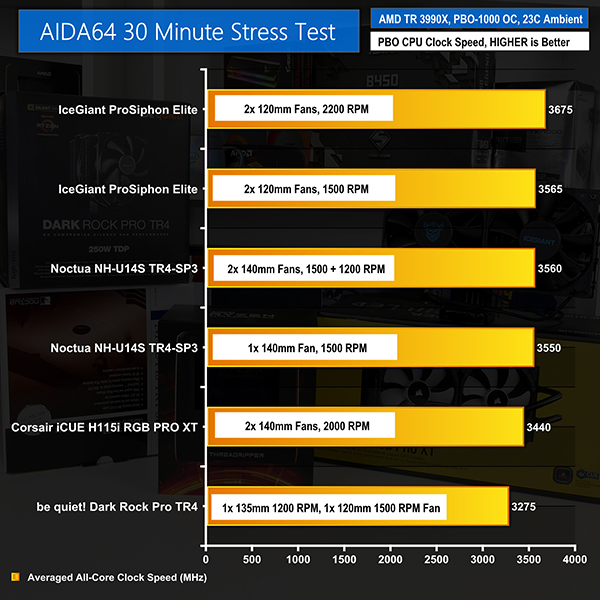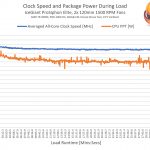Despite evident differences in cooling capability between the participants, the frequency range between the higher performance units is pretty slim. This is simply a virtue of the aggressive power versus frequency curve that AMD runs for Zen 2 whereby small gains in frequency up above 3GHz require often sizable jumps in power delivery… especially on 64 cores!
Unsurprisingly, the unit that handled the most power – IceGiant’s ProSiphon Elite in 2200 RPM fan speed form – delivered the greater averaged CPU clock frequency. Just shy of 3.7GHz on all 64 cores is a solid result, especially given that our test procedure runs the hardware inside a chassis and a slightly elevated ambient environment.
With the bundle of CPU coolers that handled around 450W CPU package power, that roughly 10% drop versus the full-speed IceGiant results in a frequency drop of just over 100MHz. 3550-3565MHz was the averaged all-core values that we recorded for the single- and dual-fan Noctua unit the slower IceGiant test run.
Dropping another roughly 10% off the power capability reduce averaged all-core clock speed by another roughly 100MHz for the Corsair H115i RGB PRO XT. And then we have the be quiet! Dark Rock Pro TR4 at the bottom of the chart with its 3275MHz result. Just shy of 3.3GHz on a 64-core chip is certainly a solid result, but it is notably slower than the competitors in our testing.
The graphs above highlight our recorded dynamics for specific test runs. While these specific graphs only pertain to a randomly picked test run from each cooler, they do highlight the thermal behaviour of each test unit. This gradient of the curve for the dissipated CPU package power is important to users who have differing user cases.
For example, the IceGiant ProSiphon Elite is clearly strong for maintaining power delivery and therefore boost frequency over the first few minutes which implies impressive short-duration cooling capabilities. By comparison, the Corsair 280mm AIO clearly sheds CPU package power and clock frequency at a faster rate initially but then reaches (a lower) steady state value quickly.
 KitGuru KitGuru.net – Tech News | Hardware News | Hardware Reviews | IOS | Mobile | Gaming | Graphics Cards
KitGuru KitGuru.net – Tech News | Hardware News | Hardware Reviews | IOS | Mobile | Gaming | Graphics Cards









